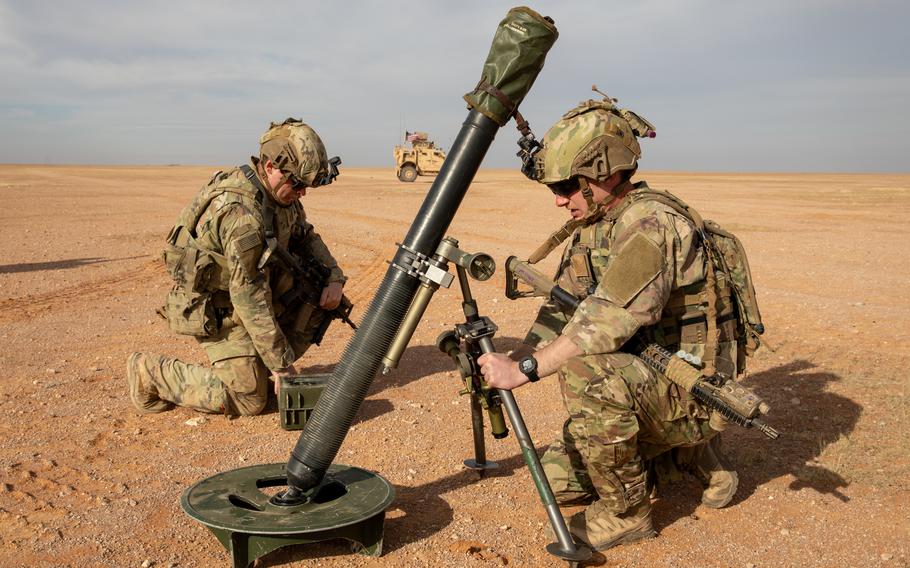
U.S. Army soldiers assigned to 4th Platoon, Alpha Company, 1st Battalion, 32nd Infantry Regiment, 1st Brigade Combat Team, 10th Mountain Division set up a mortar weapons system during a patrol of the Deconfliction Zone at Al-Tanf, Syria, Dec. 23, 2024. These regular patrols enable Coalition forces to maintain security and stability within the Combined Joint Operations Area. (Fred Brown/U.S. Army)
President Donald Trump recently informed Benjamin Netanyahu’s government in Israel that he intends to withdraw the 2,000 U.S. troops stationed in Syria to combat the remnants of Islamic State, according to Israeli media.
If true, that news is sure to stir the pot in Washington, where Trump’s pledge to remove U.S. troops from Syria in 2019 unleashed histrionics on Capitol Hill — even though by then ISIS had been thoroughly defeated and lost all of its territory.
Unfortunately, Trump’s original directive to leave was sabotaged by Pentagon leaders who snookered the president into believing that U.S. forces needed to stay for Syria’s oil.
But given the emerging tagline of Trump II: “This time it’s personal” — we can only hope the president sticks to his guns through the inevitable pushback to any discussion of withdrawal from Syria. Because despite his eccentric views on other foreign policy topics, such as the Panama Canal and Greenland, Trump’s reluctance on Syria has been spot on.
The simple truth is that Syria is in revolution — and revolutions tend to get much, much worse before they get better. The United States may have only a narrow window to pull out its troops before they are drawn into what Trump has rightly discerned “is not our fight.”
Political scientists view revolution as a special category of political change. According to the Harvard scholar Stephen Walt, revolutions entail “the destruction of an existing state by members of its own society,” who subsequently impose a fundamentally new social system with its own institutions, elites and political values. Society is reordered.
In Syria, the relatively modernized, relatively secular Assad regime has been deposed by Sunni Islamic fundamentalists. Though Hay’at Tahrir al-Sham (HTS), the militant group that led Assad’s overthrow, has promised some degree of religious tolerance — claiming, for example, that they will not force women into a strict religious dress code — the credibility of those promises is questionable.
If the Syrian Revolution follows the historical trend, the next several years will likely be tumultuous and bloody as competing factions battle to establish dominance before things settle into a new, consolidated order. Although HTS sparked the revolution, it would be surprising if they emerged victorious in the strife likely to follow. Revolutions tend to eat their young — those who start them are rarely in charge at the bitter end.
This was famously true of the French Revolution, which began as an aristocratic rebellion in 1787, morphed into a mass uprising in 1789, and then churned through multiple governments — including the Reign of Terror under Maximillien de Robespierre, who was himself executed by revolutionaries — until Napoleon Bonaparte finally took over after 12 years of chaos and violence.
The 1917 Russian Revolution, the 1958 Iraqi revolution, the 1979 Iranian revolution, and many others took similar paths. Several of the 2011 Arab Spring revolutions continue to fester, as in Yemen, Libya, and now Syria. The political upheaval following the American Revolution was largely peaceful, an exception — but it still took years to forge a stable constitutional system.
A renewed civil war in Syria would be horrendous for the Syrian people, but not out of step with history. Without downplaying the potential humanitarian consequences, Washington should avoid inflating the strategic importance of these developments.
Syria is a small, weak state, with a ruined economy, a wrecked military, and an oil industry so crippled it relied on Iran for imports. Whatever regime eventually emerges there will have no bearing on U.S. national security, because Syria is too weak to pose any direct threat to the United States.
From a cold strategic perspective, then, the Syrian Revolution should not affect U.S. national security at all, except for the U.S. troop presence there. That deployment is no longer needed, and leaving those troops in Syria exposes them to unnecessary risks in a strategic environment about to get much more dangerous.
Iran and its proxies, which would otherwise be unable to reach U.S. military targets, have struck the U.S. mission in Syria at least 125 times since October 2023, injuring numerous troops and contractors. In January 2024, an Iranian-backed militia killed three U.S. troops in a drone attack on a support base in Jordan, just across the Syrian border.
The U.S. defeated the original branch of ISIS over five years ago, when it lost all of its Middle Eastern territory. Its remnants amount to little more than a ragtag group of radicals overmatched by their local enemies. Present-day ISIS threats are overstated, and in any case they emanate from far-off Afghanistan and Pakistan, where ISIS-Khorasan (ISIS-K), the group responsible for terrorist attacks in Russia and Iran last year, is located. If need be, the U.S. can still use its formidable over-the-horizon intelligence and strike capabilities to target stray ISIS militants in Syria without boots on the ground.
Many tragedies are likely to flow from the overthrow of Bashar Assad, most poignantly for the Syrian people. Washington should pull U.S. soldiers out of an untenable conflict before it escalates, lest the Syrian Revolution become an American tragedy, too.
Rosemary Kelanic is director of Middle East Engagement at Defense Priorities.